11.10.2017
Russian Progress supply ship poised for swift trip to space station
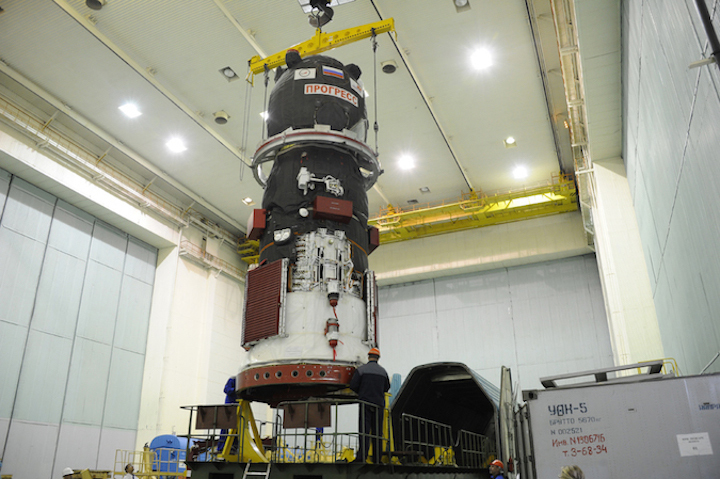
Russian ground crews are readying a robotic Progress cargo freighter for launch Thursday on an expedited trek to the International Space Station that should take less than three-and-a-half hours from liftoff to docking, cutting in half the normal transit time.
The Progress MS-07 supply ship is loaded with several tons of food, spare parts, fuel, water and breathing air for the space station’s six-person crew.
The Soyuz-2.1a rocket slated to loft the unpiloted cargo freighter rolled out Tuesday to Launch Pad No. 31 at the Baikonur Cosmodrome in Kazakhstan on a specially-designed rail car. A hydraulic lift raised the Soyuz booster on the launch pad, and a service gantry enclosed the rocket for technicians to conduct final preflight checks.
The Soyuz launch team will load RP-1 kerosene and liquid oxygen propellants into the three-stage rocket in the final hours of Thursday’s countdown, aiming for liftoff at 0932:03 GMT (5:32:03 a.m. EDT; 3:32:03 p.m. Baikonur time).
The launch time is precisely calculated to place the Progress MS-07 spacecraft on a direct course to the space station.
The modernized Soyuz-2.1a booster, featuring redesigned third stage propellant tanks and a digital flight control computer, will deliver the Progress MS-06 spaceship to orbit less than nine minutes later. Immediately after separating from the Soyuz third stage, the resupply craft will extend its power-generating solar arrays and navigation antennas, kicking off a series of thruster burns to rendezvous with the space station.
Thursday’s cargo delivery will debut an accelerated rendezvous sequence Russian officials hope to use on future crew flights, reducing crew workload and time spent inside cramped Soyuz capsules between liftoff and docking.
Until 2012, Russian cargo and crew flights launched on trajectories that took two days to travel to the space station. The leisurely rendezvous profile spread out the required maneuvers to approach the 450-ton orbiting research complex.
But Russian officials launched a Progress supply ship on an accelerated six-hour rendezvous for the first time in 2012, and began using the fast-track approach for Soyuz crew missions in 2013.
The six-hour trip occurs as the space station and visiting spaceship make four orbits of the Earth, while the even quicker journey set to debut Thursday takes place during just two orbits.
In order to make the fast-track rendezvous possible, the Soyuz rocket must launch at an exact instant just after the space station flies over the Baiknour Cosmodrome, and the Progress MS-07 cargo craft will commence approach maneuvers around 40 minutes after reaching orbit.
The Progress MS-07 spaceship is scheduled to completed its automated radar-guided rendezvous with a linkup at the space station’s Pirs docking compartment at 1256 GMT (8:56 a.m. EDT).
Quelle: SN
---
Update: 12.10.2017
.
Progress MS-07 scrub removes two orbit, 3.5hr rendezvous Station option

Roscosmos, the federal space agency of the Russian Federation, was preparing to launch the Progress MS-07 craft on a resupply mission to the International Space Station, prior to a launch abort. The scrub removes the option for Progress to debut a new super fast rendezvous with the ISS – docking to the Station just 3.5 hrs after liftoff. The next attempt is no earlier than Saturday, with a two-day rendezvous required.
Progress MS-07:
For the third time this year, Roscosmos is readying an uncrewed Progress resupply vehicle for launch to the International Space Station.

The seventh in the new line of Progress spacecraft, MS-07 was to enjoy a super fast, 2 orbit rendezvous with the ISS, arriving at the orbital outpost just 3.5 hrs after lifting off from the Baikonur Cosmodrome, had launch occurred on Thursday.
In all, Progress MS-07 is the 159th Progress mission since the program began in 1978 for resupply efforts of the Salyut 6 space station and the 70th Progress mission to the ISS, counting the two Progress flights that were not designated as resupply missions because they delivered modules to the Station.
One of those two Progress non-resupply flights occurred in 2001, when a modified Progress delivered the Pirs docking compartment to ISS.
Including this flight, 70 Progress missions have launched to ISS to date, with Progress MS-07 (or Progress 68 as it is known to NASA) being the 67th attempt of a Progress family vehicle to successfully reach the Station following the Progress 44 launch failure in August 2011, the Progress 59 launch mishap in April 2015, and the Progress 65 launch failure in December 2016.
Progress MS-07 – as a few previous Progress missions have – will ride to orbit atop the Soyuz-2.1a rocket.
Following various construction milestones, system checkouts, and cargo loading, the Progress MS-07 vehicle was fueled with its propellants and compressed gases at the filling station at Baikonur before engineers moved the craft to the Spacecraft Assembly and Testing Facility (SC ATF).

There, Progress MS-07 underwent final checkouts before undergoing encapsulation with its payload fairing.
On 6 October, the encapsulated Progress was transferred to the Spacecraft Integration and Test Facility (SC ITF), where it was mated to the third stage of its Soyuz 2.1a carrier rocket.
The integrated third stage/spacecraft was then mated to the core/second stage of the Soyuz on 9 October.
The Soyuz rocket and its Progress passenger were then moved to pad 31/6 at the Baikonur Cosmodrome in Kazakhstan via rail transport on 10 October.

Liftoff was scheduled for 09:32:03 GMT (05:32:03 EDT – 15:32:03 local time at Baikonur) on Thursday, 12 October 2017.
Under the initial plan, after an 8 minute 45 second ascent, the Soyuz-2.1a rocket was to deliver Progress MS-07 into its initial orbit to begin a super fast tracked, two-orbit (3.5 hr) rendezvous with the ISS.
This new approach trajectory and sequence was to be tested on Progress MS-07 ahead of the timeline’s anticipated use on the Soyuz crew rotation flight set for December.
Improvements to the Soyuz rocket and Soyuz crew vehicles have enabled the somewhat steady use of fast rendezvous with the ISS over the past several years – thereby significantly alleviating crew stress for those riding aboard Soyuz, which is small and cramped.
However, due to an unknown reason, the launch was scrubbed seconds prior to launch, meaning the next opportunity will be Saturday and that will see a return to the old two day rendezvous.
The previous two-orbit rendezvous timeline:
Progress missions are routinely used to test new procedures ahead of their use on crewed missions of Soyuz.

The new super fast rendezvous was to have tested the Progress MS-series (which uses the same software and engine systems as the Soyuz MS-series) craft’s ability to perform the complex rendezvous profile under a strict set of conditions and a tight timeline.
(Note: The below times and events are part, not all, of NASA’s rendezvous timeline – full document available for download on L2 – provided to NASASpaceflight.com. Real-time flight events and spacecraft performance usually cause the below timeline to shift by a few seconds.)
After orbit insertion is accomplished, the Progress’ orbital parameters will be immediately discerned via spacecraft communication with Vostochny Cosmodrome’s tracking stations in eastern Russia.

If all of those parameters meet the specifications needed for two-orbit rendezvous, MS-07 will embark on its super fast trajectory to the ISS.
Options exist to default after launch to a standard 34 orbit, 2 day rendezvous profile should something occur in the opening minutes of the mission that would preclude fast track docking.
Under the two orbit, 3.5hr rendezvous plan, Progress MS-07 will perform the DV-1 burn ~41 mins into the mission – changing its velocity by 24.52 m/s and beginning the process of aligning itself with pinpoint accuracy into the ISS’s approach corridor.
The automated rendezvous sequence will start ~62 mins after liftoff.

Progress will then execute the Impulse 1 burn 81 mins after liftoff, further changing its velocity by 46.559 m/s.
Onboard the Station, the crew will begin final preparations for Progress MS-07’s arrival 93 mins after the craft’s launch when Motion Control of the Station will be transferred from the USOS (United States Operating Segment) to the Russian Segment.
This will be followed by a short 1.992 m/s delta-V Impulse 2 burn by Progress and the activation of the Kurs-P communication system on the ISS’s Zvezda Service Module.
One minute later, Progress’ corresponding Kurs-NA system will be activated at a Mission Elapsed Time (MET) of ~1 hr 53 mins.

Progress will then conduct the Impulse 3 burn (delta-V of 35.917 m/s) at MET 2 hrs 6 mins.
Confirmation of Kurs-P range data from the Service Module’s system will be taken at MET 2 hrs 19 mins – at which point Progress will be just 45 km (28 mi) behind the Station.
Just 5 mins later, Progress MS-07 will have closed another 15 km (9.3 mi) on the Station, at which point its Kurs-NA antenna will be activated.
Eight minutes later, at MET 2 hrs 32 mins, a full-up Kurs test between Progress and the ISS SM will occur – and Progress will be just 15 km (9.3 mi) from the Station.
Once Progress is 9 km from ISS, the Station’s VHF-2 transmitter will be activated. This transmitter is a vital part of Progress’ TORU (Teleoperated Mode of Control) automated docking system’s ability to safely and accurately guide the craft through a completely automated rendezvous to ISS.

VHF-2 transmitter activation will occur at MET 2 hrs 38 mins with Progress’ VHF receiver being activated 11 mins later.
At MET 2 hrs 51 mins, Progress will perform the Impulse 4 burn to change its velocity by 5.897 m/s and bring itself to the Ballistic Targeting Point 2 km from the ISS just seconds later.
At this point, Progress MS-07 TORU command link tests, Progress TV camera activation, and final ISS system power-downs and command inhibits will be put in place.
The Impulse 5 and 6 burns will further change Progress’ velocity by 5.755 m/s and 1.705 m/s, respectively.

Progress flyaround of the ISS will commence at MET 3 hrs 1 min, at the conclusion of which Progress will be properly aligned with nadir docking port one on the Pirs docking compartment (DC).
At this time, Progress will initiate station keeping operations to hold relative position with the ISS as final alignment and system checks are completed.
Once a “go” to proceed is given, Progress will begin its final approach at approximately MET 3 hrs 14 mins.
Docking is anticipated at ~MET 3 hrs 24 mins.

At the moment of docking, the ISS will enter free drift to help dampen out relative motion between the two vehicles. Once those dispersions are gone, Progress will drive its hooks into the DC1 nadir port to achieve hard dock.
After this, the vestibule between the Station and Progress MS-07 will be pressurized ahead of hatch opening.
This plan has now been lost, but the Progress will eventually make the trip to the Station.
Once docked, the Station crew will begin the process of offloading / transferring 1,940 lbs (880 kg) of propellant, 51 lbs (23 kg) of oxygen, 53 lbs (24 kg) of air, 926 lbs (420 kg) of water, and 2,976 lbs (1,350 kg) of dry cargo, spare parts, and similar items from the MS-07 spacecraft.
In all, MS-07 is bringing 5,946 lbs (2,697 kg, or 2.9 tons) of equipment, supplies, and life support elements to Station.
While all the cargo aboard MS-07 is valuable and necessary in the long-term view, the Station is incredibly well stocked with all consumables at present.

In fact, the ISS is so well stocked that NASA public affairs told NASASpaceflight.com’s Chris Gebhardt that, “Even without Progress [MS-07], consumables on Station can last through next spring.”
After Progress MS-07, only two more resupply missions to Station remain for 2017.
Orbital ATK is targeting NET (No Earlier Than) 10 November for the launch of the Cygnus OA-8E missionon the company’s Antares rocket from the Mid-Atlantic Regional Spaceport in Virginia.
SpaceX will quickly follow with the CRS-13 mission of Dragon on NET 28 November 2017.
Quelle: NS
+++
Launch of Russian Cargo Mission Scrubbed
Launch of the Russian Progress 68 cargo craft has been scrubbed for today. The next launch attempt will be no earlier than Saturday Oct. 14 at 4:46 am EDT (2:46 p.m. local time in Baikonur). Following a 34-orbit, two-day trip, Progress 68 would arrive at the Pirs Docking Compartment of the International Space Station for docking on Monday, Oct. 16. Roscosmos technicians in Baikonur are analyzing the cause of the scrubbed launch. To join the conversation about the space station and Progress 68 online, follow @space_station on Twitter.Launch of Russia’s Progress resupply ship rescheduled for Oct. 14
The resupply ship will deliver 2.5 tonnes of various cargoes for the International Space Station
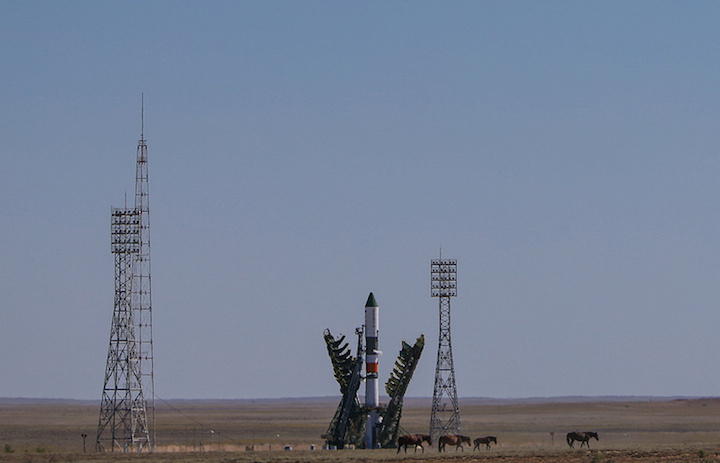
The launch of a Progress MS-07 cargo spacecraft aboard a Soyuz-2.1a carrier rocket from the Baikonur space center in Kazakhstan has been rescheduled for October 14, a commentator in the Flight Control Center said on Thursday.
"The launch of a Progress MS-07 resupply ship has been rescheduled for 11:46 Moscow time on October 14," the commentator said.
The resupply ship will deliver 2.5 tonnes of various cargoes for the International Space Station, including fuel, water, compressed gases, and also equipment for comprehensive scientific experiments.
Quelle: TASS
---
Update: 14.10.2017
Launch Progress-MS-07

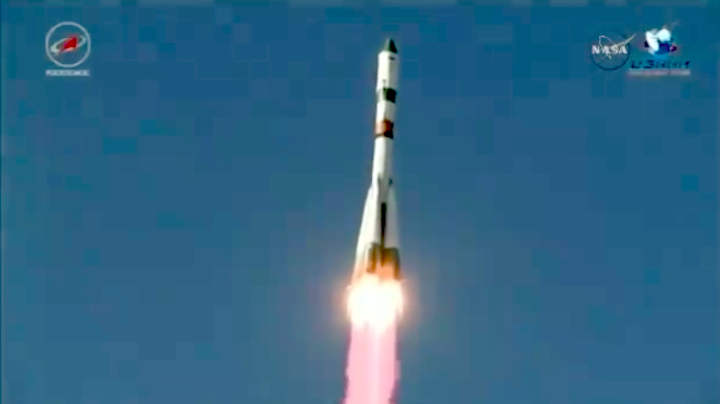
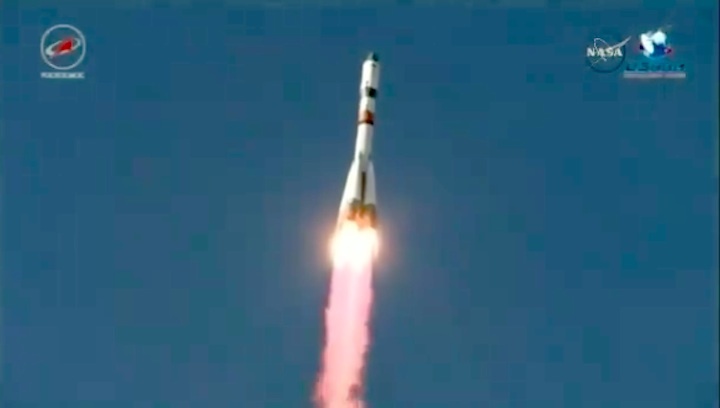
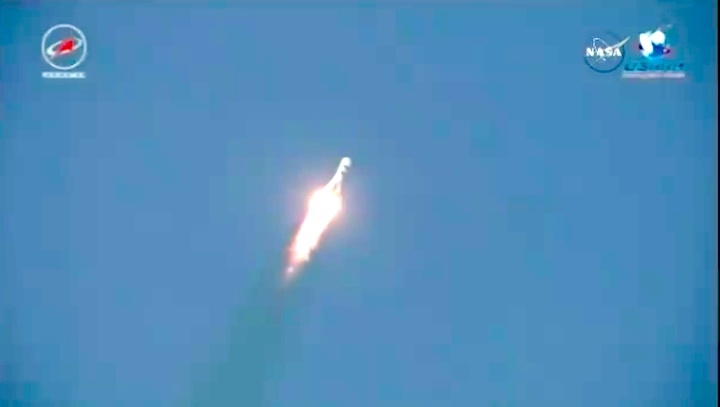
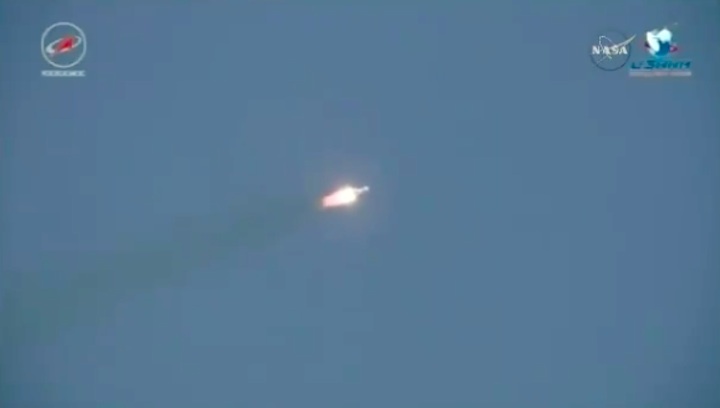
Quelle: Roscosmos
